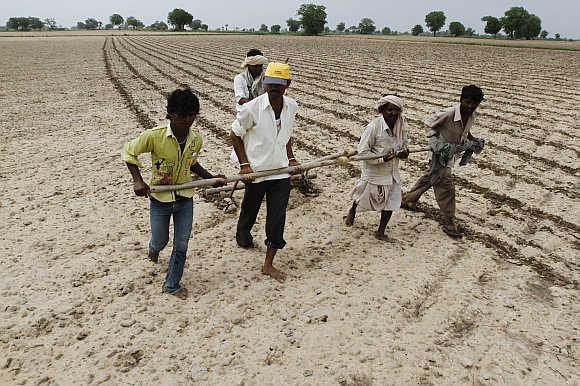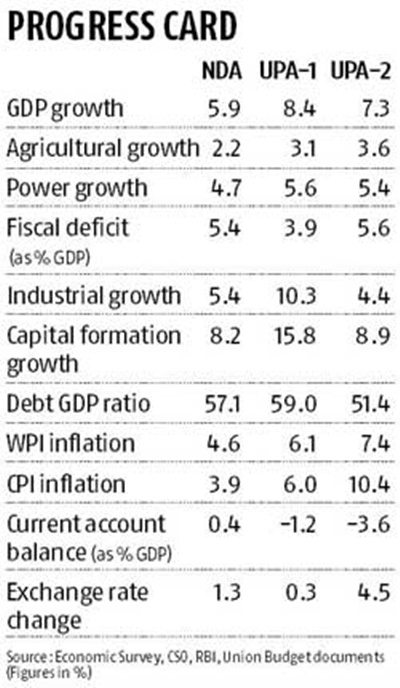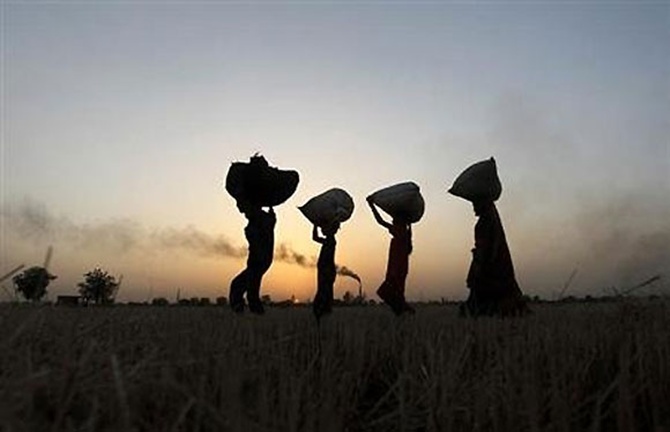 | « Back to article | Print this article |
How prudent states helped in curbing India's fiscal deficit
Had the states not fulfilled their commitment on fiscal consolidation, the overall fiscal deficit would have widened, A K Bhattacharya.
In the heat and dust raised by the current debate over the authenticity of the Union government's fiscal deficit numbers, little attention has been paid to what the states have done in the last few years on the fiscal consolidation front.
A recent report from the Reserve Bank of India has shed some light on how India's 28 states and two Union Territories have handled their public finances, offering a few interesting takeaways for those who worry about India's fiscal mess.
For the uninitiated, the importance of the state budgets should not be underestimated. The total size of the combined budgets of 28 states and two Union Territories (those of Delhi and Puducherry) is as large as that of the Union government.
Click NEXT to read more…
How prudent states helped in curbing India's fiscal deficit
Thus, at the aggregate level, the collective impact of what the states achieve or fail to achieve on the fiscal consolidation front is as high as that of the Union finance minister's fiscal numbers.
That is also why the difference in the outcome of the fiscal consolidation efforts of these 28 states and two Union Territories, and those of the Union government is a cause for serious concern for India's macroeconomists.
Take a look at these figures for the last three years and you will see that the differential has always ranged between two and four percentage points, i.e. the states' combined fiscal deficit has been lower than that of the Union government by as much as four percentage points in one year and by over two to three percentage points in the remaining years.
Click NEXT to read more…
How prudent states helped in curbing India's fiscal deficit
In 2010-11, for instance, the Centre's fiscal deficit was 4.8 per cent of gross domestic product (GDP) and the combined fiscal deficit of states and Union Territories for that year was 2.1 per cent.
In the following three years, the fiscal deficit numbers for the Centre and the states plus UnionTerritories have been, respectively, 5.7 per cent and 1.9 per cent in 2011-12, 4.9 per cent and 2.3 per cent in 2012-13 and 4.6 per cent and 2.2 per cent in 2013-14.
Three points should be noted from the different trajectories of the fiscal deficit numbers of the Centre and those for the states plus Union Territories.
One, the states and Union Territories have stayed loyal to their commitment to rein in their fiscal deficit below three per cent of gross state domestic product or GSDP, as mandated in the Thirteenth Finance Commission.
Click NEXT to read more…
How prudent states helped in curbing India's fiscal deficit
The same cannot be said of the Centre. It has been wayward and had even declared a pause on its own programme of fiscal consolidation outlined in the Fiscal Responsibility and Budget Management Act.
Two, finance ministers of the Union government will cite many reasons to justify the slippage but what cannot be brushed aside is that but for the states and Union Territories staying well below their committed fiscal deficit figure, the overall government fiscal deficit for the country (including the Centre and states) would have widened even further.
And three, even though the Centre has seen such a sharp deviation of the mandated fiscal consolidation path, the trajectory seen in the last few years is a cause for some comfort.
The Centre's fiscal deficit has declined every year since 2011-12, though at a slow pace.
Click NEXT to read more…
How prudent states helped in curbing India's fiscal deficit
From around 5.7 per cent of GDP in 2011-12, it moved down to 4.6 per cent this year and is slated to decline to 4.1 per cent next year, even though these projections are being doubted.
Dig a little deeper into the states' fiscal deficit numbers and you will come across three more interesting trends. One, the share of the own tax revenues that is mobilised by them has held firm at over six per cent of the combined GSDP. This is a welcome sign since the states and UnionTerritories have not relaxed on their own revenue raising efforts.
The benefits of this fiscally prudent stance will accrue in larger measure when the country goes in for the much-awaited goods and services tax that will immediately see an increase in their revenue mobilisation.
Click NEXT to read more…
How prudent states helped in curbing India's fiscal deficit
Two, central transfer to states and Union Territories (consisting of devolution of taxes and grants-in-aid from the Centre) has also been rising steadily and, in fact, stands at over five per cent of GSDP. The Centre will naturally complain about these transfers but nothing is truly objectionable to this healthy trend.
Three, the states are now poised to get an even larger share of resources under the new structure of centrally-sponsored schemes, wherein the states and Union Territories with elected Assemblies will see these funds directly transferred from the Central kitty to theirs.
This is why there is a sharp rise (almost 184 per cent) in central assistance to plans of states and Union Territories in the interim Budget numbers for 2014-15.
Some states are, therefore, waiting for the final numbers that will become available from the full Union Budget later this year and hence have gone for a Vote-on-Account now, and will come out with a full Budget later.
Click NEXT to read more…
How prudent states helped in curbing India's fiscal deficit
The flip side of these rosy forecasts for state finances is that a time bomb by the name of the Seventh Central Pay Commission will be ticking and is likely to explode next year.
In the years after 2007-08, the fiscal deficit for states and Union Territories shot up sharply to exceed the two per cent-mark, thanks largely due to the impact of the Sixth Pay Commission on the pay-scales of employees of their governments.
The big question now is whether the state finances can absorb the next Pay Commission's impact and whether the higher transfer of resources under central assistance will minimise or eliminate the damage. That, only time will tell.
Note: For states, the 2012-13 numbers are Revised Estimates and those for 2013-14 are Budget Estimates. For the Centre, the 2013-14 numbers are Revised Estimates.







